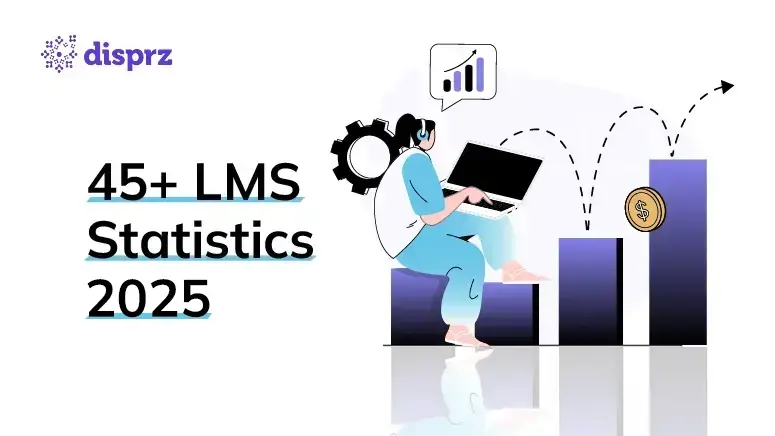LMS Evolution From AI to Gamification!
Explore the latest trends and statistics in the global Learning Management System (LMS) market, from regional growth to industry-specific advancements. Discover how cloud-based solutions, artificial intelligence (AI), and gamification are shaping the future of corporate training. Dive into the data and see what’s driving the evolution of LMS!
Global LMS Market Statistics 2025
The corporate LMS market is set for significant growth, driven by the shift to agile, cloud-based platforms and increased demand for upskilling.

1. Projected growth: US $43.95 billion and a CAGR of 31.87% (2023-2028).
2. Global eLearning market growth: 14% annually
3. Asia’s eLearning growth rate: 17.3% per year.
4. Mobile learning is expected to increase at a CAGR of 36.45% (2020-2027).
Regional LMS Statistics 2025
North America Stats
The LMS market in North America is growing steadily, driven by leadership in corporate training and talent management.

5. North America's LMS market CAGR: 4%
6. Canvas market share in North America: 35%.
7. North America’s contribution to global market growth: 33% during the forecast period (2024-2028).
Europe LMS Stats
The European LMS market is expanding significantly due to rising demand for digital learning tools and online education.

8. The European eLearning market is expected to grow by US $28 billion over 5 years.
9. The European LMS market value is projected to rise from US $4,954 million in 2021 to US $25,014 million by 2030, with a CAGR of 19.42% from 2022 to 2030.
Asia-Pacific LMS Stats
10. The Asia-Pacific LMS market is expected to experience substantial growth, with its value projected to rise from US $3,824 million in 2021 to US $20,613 million by 2030, driven by digital infrastructure enhancements and technology adoption.

11. Market value is expected to rise from US $3,824 million in 2021 to US $20,613 million by 2030.
12. Reflecting a CAGR of 20.28% from 2022 to 2030.
13. Growth was driven by government initiatives, digital infrastructure improvements, and the adoption of video conferencing tools.
14. A large student population and advancing technology contribute to the rising demand for eLearning and online education.
Latin America LMS Stats
Latin America is becoming a key player in the global LMS market, with a strong projected growth rate driven by rising eLearning adoption and government incentives.

15. Projected CAGR of 17.08% during the forecast period.
16. Rapid growth is driven by increased eLearning adoption, especially in Brazil.
17. Governments in Brazil and Argentina offer incentives to LMS providers.
18. Expansion and globalization contribute to rising LMS adoption in South America.
19. Focus on enhancing education quality and boosting employability through digital learning.
Middle East and Africa LMS Stats
The MEA LMS market is set to experience significant growth, driven by the increasing adoption of cloud-based solutions and diverse delivery modes.

20. Projected to grow from US $564.20 million in 2021 to US $1,534.95 million by 2028.
21. CAGR of 15.4% during this period.
22. Cloud-based LMS led the market in 2020 and is expected to continue growing rapidly.
23. Market segments include deployment mode, delivery mode, end-user, and country.
24. Delivery modes encompass distance learning, instructor-led training, and other methods.
Industry-Specific LMS Statistics 2025
Retail Management
25. The Global Retail LMS Software Market is set to grow significantly, reaching US $9.8 billion by 2027, driven by increased demand for digital learning and advancements in technology.

26. Growing at a CAGR of 13.2% from 2020 to 2027.
27. Driven by the demand for enhanced customer experiences, rise in online shoppers, and investment in digital learning.
28. Advancements in AI, big data analytics, and cloud-based services contribute to market growth.
29. Designed to manage, track, and report on employee training and development in the retail sector.
Healthcare LMS Statistics
LMS are becoming crucial in the evolving healthcare sector, driving improvements in training, compliance, and operational efficiency.
30. The global market for medical education is projected to exceed US $48.7 billion by 2031.

31. Online learning platform users are expected to reach US $57 million by 2027.
32. The healthcare LMS market is forecasted to grow at a US $48.7 CAGR of 25.42% from 2024 to 2029, reaching US $7.85 billion by 2029.
33. Global medical education market value: US $43.89 billion in 2023, is projected to grow at a CAGR of 5.5% (2024 and 2032).
34. Healthcare education market value: US $98.58 billion in 2022, expected to reach US $190.74 billion by 2030, with a CAGR of 8.6% (2023-2030).
35. Global healthcare LMS market value: US $1.1 billion in 2022, projected to exceed US $3.5 billion by 2030 with a CAGR of 22%.
36. Anticipated growth of the healthcare LMS market: US $4.4 billion by 2030 with a CAGR of 19.1% (2023-2030).
Manufacturing LMS Stats
37. The LMS for Manufacturing Market is growing rapidly, projected to reach US $98.69 billion by 2030, driven by its role in organizing and managing industry-specific training and development programs.

38. Valued at US $20.33 billion in 2023.
39. Expected to grow at a CAGR of 16.4% from 2024 to 2030.
40. Supports training with manuals, interactive modules, simulations, assessments, and videos tailored to industrial needs.
Education LMS Stats
The EdTech industry is undergoing significant changes due to the COVID-19 pandemic and potential economic challenges in 2023. These shifts are reflected in the latest K-12 education statistics, highlighting a move towards student-centered learning that offers greater autonomy to learners.
The EdTech industry is evolving rapidly due to the COVID-19 pandemic and economic shifts, with a notable move towards student-centered learning in K-12 education.

41. The K-12 online education industry is projected to grow at a CAGR of 8.3%, reaching US $12930 million by 2028.
42. The eBook market size is estimated at US $17.20 billion in 2024, expected to reach US $21.73 billion by 2029, growing at a CAGR of 4.78% during the forecast period (2024-2029)
43. Audiobooks are projected to grow at a CAGR of 24% between 2023 and 2028.
Technology LMS Statistics
The integration of AI with LMS enhances personalization and engagement in learning, leading to more effective and efficient business operations through real-time assistance and data-driven decision-making.

44. 81% of employees believe AI integration will boost their performance and enable data-driven decision-making.
45. AI-based LMS can automate workflows, detect and prevent fraud, and provide personalized experiences.
46. AI integration is expected to significantly enhance organizational efficiency and productivity, driving market growth.
Key LMS Trends in 2025
Course Development and Content Administration
An efficient LMS should simplify course creation and management with built-in features, unlike basic systems that need external tools. Migrating to a modern LMS streamlines your tech stack, enabling easy creation of personalized training courses and centralizing all materials for easy access.
Customizable LMS
A custom LMS provides tailored solutions to fit your organization’s unique training needs, with specific features, white-label branding, and workflows aligned with your goals. It offers flexibility for creating personalized learning paths, assessments, and content that enhance engagement and performance.
In-Built Reports and Dashboards
Effective training programs depend on strong reporting and analytics to track learner performance. Many LMS platforms offer customizable dashboards with detailed charts and visualizations, helping administrators monitor engagement, completion rates, and performance. These tools support data-driven decisions to enhance learning outcomes and maintain training standards.
Local Integrations
An LMS’s effectiveness improves with integrations like Salesforce or tools such as Zoom and Slack. These connections streamline learning, create seamless workflows, and consolidate data, especially useful during LMS transitions.
Blended Learning
Blended learning combines online and in-person instruction to cater to diverse learning styles. Some LMS platforms enhance this approach with role-play simulations for practical experience. By allowing employees to choose their preferred learning methods and schedules, this strategy boosts engagement and retention.
Social Learning
Integrating social learning features into an LMS enhances training by enabling learners to interact, ask questions, and share insights via message boards and forums. This peer-to-peer approach boosts learning while reducing the trainers' workload.
Gamification
Gamification elements like leaderboards and badges can make training more engaging and effective. Research shows that these features can boost productivity and profitability. Many LMSs incorporate such interactive components to enhance learner retention and engagement.
Conclusion
The LMS market is rapidly expanding across various sectors, driven by the rise of cloud-based solutions, gamification, and AI integration. As organizations increasingly adopt advanced LMS platforms to enhance training and productivity, staying ahead in this dynamic landscape is crucial. Discover how the Disprz platform can transform your learning management with a personalized demo to see the future of corporate training!








